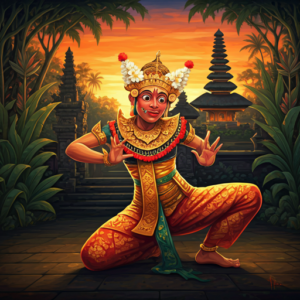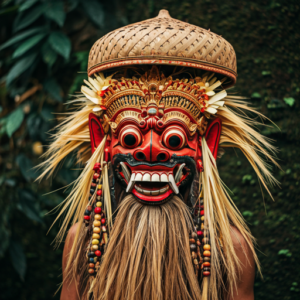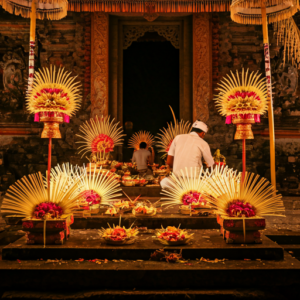
Balinese storytelling is an intricate and vibrant tradition that plays a vital role in the cultural and spiritual life of the island. Known for its rich tapestry of folklore and legends, Balinese storytelling is an art form that encompasses dance, theater, music, and oral narration, creating a multidimensional experience that captivates audiences and preserves the island’s cultural heritage. This tradition not only entertains but also imparts moral lessons, historical knowledge, and spiritual wisdom, ensuring that the values and beliefs of the Balinese people are passed down through generations.
The Role of Storytelling in Balinese Culture
In Bali, storytelling is not merely a form of entertainment; it is a profound cultural practice that serves multiple purposes:
- Education and Moral Instruction: Many Balinese stories are imbued with moral lessons and ethical guidelines. These tales often depict the triumph of good over evil, the importance of virtue, and the consequences of moral transgressions. Through these narratives, children and adults alike learn about the values that underpin Balinese society.
- Preservation of History and Tradition: Storytelling is a means of preserving the historical and cultural heritage of Bali. Myths and legends often incorporate historical events, notable figures, and traditional customs, ensuring that these elements remain alive in the collective memory of the community.
- Spiritual and Religious Significance: Balinese storytelling is deeply intertwined with the island’s Hindu-Buddhist traditions. Many stories are derived from sacred texts like the Ramayana and Mahabharata, as well as local myths that explain natural phenomena, religious practices, and the origins of temples and sacred sites.
- Community Cohesion: Storytelling events are communal activities that bring people together. Whether performed during temple festivals, village gatherings, or family occasions, these stories foster a sense of unity and shared identity among the Balinese people.
Forms of Balinese Storytelling
Balinese storytelling takes on various forms, each with its unique style and presentation. These forms include traditional dance-dramas, shadow puppetry, oral narratives, and more.
- Wayang Kulit (Shadow Puppetry): Wayang Kulit is a traditional form of shadow puppetry that uses intricately carved leather puppets to tell stories. The puppets are manipulated by a dalang (puppet master) behind a white screen, with a light source casting their shadows. The dalang not only manipulates the puppets but also provides voices and narration, bringing the characters and story to life. Wayang Kulit performances often depict episodes from the Ramayana and Mahabharata, as well as local myths and folklore.
- Legong and Barong Dances: These classical dance forms are integral to Balinese storytelling. The Legong dance, performed by young girls, tells romantic and heroic tales through intricate movements and expressive gestures. The Barong dance, on the other hand, dramatizes the eternal battle between good (Barong) and evil (Rangda), using elaborate costumes and dynamic choreography to convey the story.
- Kecak (Monkey Chant): The Kecak dance is a unique form of storytelling that involves a chorus of male performers sitting in a circle, chanting „cak“ in rhythmic patterns while enacting scenes from the Ramayana. The hypnotic chant, combined with dramatic movements and gestures, creates a powerful and immersive storytelling experience.
- Oral Narratives: Oral storytelling remains a cherished tradition in Bali, with elders and community leaders recounting myths, legends, and historical tales to younger generations. These narratives are often shared during family gatherings, religious ceremonies, and communal events, ensuring that the stories remain vibrant and relevant.
Prominent Balinese Folktales and Legends
Balinese folklore is rich with enchanting tales that reflect the island’s unique cultural and spiritual landscape. Some of the most beloved stories include:
- The Legend of Barong and Rangda: This epic tale depicts the eternal struggle between Barong, a benevolent spirit in the form of a lion, and Rangda, a malevolent witch. Barong represents good, protection, and health, while Rangda embodies chaos, destruction, and illness. Their battle symbolizes the balance between positive and negative forces in the universe. This legend is dramatized in the Barong dance, a popular and visually stunning performance that captivates audiences with its dramatic tension and vibrant costumes.
- Calonarang: The story of Calonarang centers on a powerful witch who wreaks havoc on a kingdom with her dark magic. The tale is a cautionary one, highlighting the dangers of unchecked power and the importance of moral integrity. It is often performed as a dance-drama, combining elements of magic, suspense, and moral lessons.
- The Origin of Bali’s Sacred Springs: Various legends explain the origins of Bali’s numerous sacred springs, which are considered vital for religious purification and agricultural fertility. One such tale involves the god Indra, who created the spring at Tirta Empul to vanquish the demon king Mayadenawa. The water from this spring is believed to have healing properties and is used in purification rituals.
- The Story of Manik Angkeran: This legend tells of Manik Angkeran, a young man whose greed leads him to steal sacred jewels from a dragon guarding a holy spring. His actions bring misfortune upon himself and his family, ultimately leading to his redemption through the intervention of the gods. The story underscores the themes of greed, repentance, and divine justice.
The Influence of Hindu Epics
The Ramayana and Mahabharata, two ancient Indian epics, have had a profound impact on Balinese storytelling. These texts provide a rich source of narratives that are adapted and retold in various forms across the island.
- Ramayana: The Ramayana, which chronicles the adventures of Prince Rama, his wife Sita, and his loyal companion Hanuman, is a cornerstone of Balinese narrative tradition. Episodes from the Ramayana are frequently depicted in dance-dramas, puppet shows, and carvings. The story’s themes of duty, loyalty, and the triumph of good over evil resonate deeply with Balinese cultural values.
- Mahabharata: The Mahabharata, a grand epic of familial conflict and divine intervention, offers numerous stories and characters that are integrated into Balinese folklore. The tale of Bhima, a powerful warrior and son of the wind god, is particularly popular. His strength, bravery, and moral fortitude make him an ideal hero in Balinese storytelling.
The Preservation and Evolution of Balinese Storytelling
As with many traditional art forms, Balinese storytelling faces challenges in the modern era, including the influences of globalization, tourism, and technological change. However, efforts are being made to preserve and adapt these traditions for contemporary audiences.
- Cultural Education: Schools and cultural centers in Bali are incorporating storytelling into their curricula, teaching young people the skills and knowledge needed to keep the tradition alive. These programs often include training in dance, music, puppetry, and narrative techniques.
- Tourism and Cultural Performances: The popularity of Balinese storytelling among tourists has provided new opportunities for its preservation. Performances of traditional dances, puppet shows, and oral narratives are often included in cultural tours, helping to sustain the art form and educate visitors about Balinese culture.
- Adaptation and Innovation: Balinese storytellers are also embracing new media and technologies to reach wider audiences. Digital recordings, online platforms, and multimedia presentations allow these ancient stories to be shared with people around the world, ensuring their continued relevance and appreciation.
Conclusion
The art of Balinese storytelling is a vibrant and multifaceted tradition that reflects the island’s rich cultural heritage and spiritual depth. Through dance, puppetry, music, and oral narratives, Balinese storytellers bring to life a world of gods, heroes, and mythical creatures, imparting timeless lessons and preserving the island’s history and values. As this tradition continues to evolve and adapt, it remains a vital and cherished aspect of Balinese identity, offering a window into the soul of the „Island of the Gods.“ Exploring Balinese folklore and legends is not just an encounter with enchanting tales, but a journey into the heart of a culture that values the power of storytelling as a means of connecting past, present, and future.





